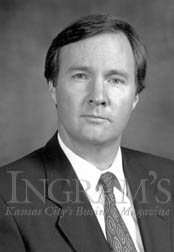by stephen s. soden
Uncle
Sam Says Turbo Charge
Your Future

In the future, many things about 1999 and
2000 will be remembered with positive thoughts—the nonexistent Y2K
bug, the peak of a record bull market, celebration of the beginning of
a new century, and many other personal memories. On the other hand, 2001
will be a year we all want to forget—acknowledgement of a recession;
the terrible events of Sept. 11; a possible protracted war against terrorism;
ENRON, the largest U.S. corporate bankruptcy in history; etc.
My point is that while these are things of the past, we should not dwell
on them. Now is the time to focus on the future.
The future is bright and recovery is underway. New opportunities to enhance
your personal wealth arise in 2002. You’ve probably seen a television
advertisement from one of Kansas City’s finest financial institutions
that illustrates so well that federal legislation created over 400 tax-law
changes in 2001. While the administration and Congress continue to battle
over economic stimulus packages, they did pass something that can significantly
improve your future financial picture.
The tax law changes that can personally impact you are numerous. To highlight
a few:
• The enhanced education IRAs, also known as Coverdell education
savings accounts, have been significantly liberalized. The annual contribution
limit is now $2,000, up from $500. They also may be used for a wider array
of education expenses.
• The 529 plan provisions for higher education, also known
as qualified tuition programs, have been expanded to provide for tax-free
distributions. No longer are the taxable earnings taxed to the child.
• New deduction for higher education expenses. Eligible taxpayers
may claim a new deduction for higher education expenses whether they itemize
or not.
• 401(k) changes are significant and there are probably more
to come to protect this important retirement program. First, you should
be aware of higher elective deferral limits. They are up to $11,000 for
2002, and those over age 50 can make extra, catch-up contributions. These
limits also apply generally to 403(b), SEP’s, and section 457 (governmental).
Additionally, the SIMPLE plan contribution limit increased $500 and the
catch-up provisions also apply.
• Sweeping estate and gift-tax law changes create the need
for a critical review of your estate plan. The annual gift-tax exclusion
was increased to $11,000 and the
unified credit to $1 million. The top estate and gift-tax rate decreased
by 5 percent to 50 percent. There are many more than we can cover here,
and you should be aware that these changes would continue until 2010.
This will require continuous monitoring.
• Relaxation of IRA withdrawals limitations and more portability
between types of plans.
• Higher IRA/Roth IRA contribution limits. The 2002 maximum
annual contribution is $3,000, and a taxpayer over 50 can make an additional
catch-up contribution of $500.
The list goes on, but my intention is to stimulate you to review your
total financial picture with your financial advisers and planners. While
it may be easier to procrastinate and some of these changes may not seem
significant in present dollars, the long-term compound effect is significant.
The journey to financial success is long, and you need to constantly adjust
to changes so that you don’t miss your mark.
The fall and winter of 2001 and 2002 have created a positive environment
for financial advisers and planners to review all these changes and be
prepared to help you implement new game plans to increase your personal
wealth and security. Now is the time to talk to your legal, tax and financial
advisers. It might not have been a New Year’s resolution, but 2002
can be the year to adjust your heading and turn on the turbocharger to
make up for lost time and opportunity.
There are new and improved ways to put additional dollars into investment
programs to provide more dollars to you and your family later, when you
will need them most.
Stephen S. Soden is president and CEO of Jones & Babson Inc.
He can be reached by phone at 816.751.5749 or by e-mail at ssoden@jbfunds.com.